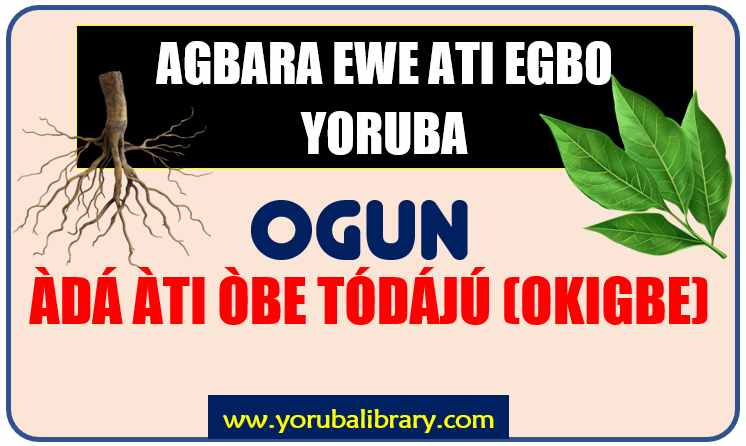
support@yorubalibrary.com
+2348073529208, 07038599574

Among the Yoruba, protection has always been a central part of life. In the past, when wars, community conflicts, and hunting expeditions were common, people sought not only physical strength but also spiritual defense. One of the most remarkable practices that arose from this worldview is Ògùn Àdá àti Òbe Tódájú, also known as Okigbe.
This refers to traditional fortification believed to protect the body from injuries caused by cutlasses, knives, or other sharp objects. It is not merely physical but spiritual, combining herbs, roots, chants, and rituals to create what was considered a shield around the body. Such practices gave warriors courage, instilled fear in enemies, and offered re-assurance to farmers and hunters in their daily lives.
Today, Ògùn Àdá àti Òbè still has cultural value, reminding us of how the Yoruba balanced survival, bravery, and belief in ancestral wisdom.
Disclaimer
Yoruba Library and its Team will not be held liable for improper usage or any loss arising from improper use, wrong application, inability to find needed materials, or misinterpretation of this article. This article is provided strictly for guidance and educational purposes.
Symptoms or Fears that Led People to Seek Okigbe
People turned to Ògùn Àdá àti Òbe Tódájú when they experienced or feared:
• Threat of Violence:
In times of war or disputes, there was fear of cutlass or knife attacks.
• Hunters and Warriors’ Safety:
Those who hunted wild animals or fought in battles desired protection from serious wounds.
• Spiritual Attacks:
Belief that enemies could use sharp weapons physically or spiritually to cause harm.
• Occupational Accidents:
Farmers and laborers working daily with cutlasses sought safety from accidental cuts.
• Need for Boldness:
Some desired this fortification to appear fearless and courageous before others.
How Our Forefathers Treated the Need for Okigbe in the Past
• Scarification/incision marks with medicine rubbed into them.
• Ritual baths for spiritual cleansing and protection.
• Incantations (ọfọ̀) recited to activate the medicine.
• Herbal preparations made from selected leaves, roots, and bark. Amongst leaf and roots highly potent for Okigbe include:
1) Ewe Akoko
2) Ewe Abere
3) Ewe Gbanja
4) Ewe Gbaguda
5) Egbo Igi Osun
6) Egbo Igi Aayan
7) Epo Obo
Have you heard of Yoruba Herb Dictionary? This contains names of Yoruba Leaf, Roots, Barks, Characteristics, Properties & Identification with HD Pictures. Order below or download sample here
A-Z HERBS & LEAF DICTIONARY #4KOne Yoruba proverb says "Bí olóde ò kú, òde rè kì í wu Gbégi". Do you know that Gbégi is actually a leaf/plant? Get Yoruba Proverbs on Plants and Herbs, which is a collection of Untold Wisdoms Hidden in Leaf and plants comprising their Life Applications & Moral Teachings. Order below or download sample here
YORUBA PROVERBS ON PLANTS #4KThe Healing Process in Traditional Practice
• Herbal Preparation
Special leaves, roots, and bark were gathered with care, often at dawn when believed to hold more power.
• Scarification and Application
Tiny cuts were made on specific parts of the body, and the prepared herbal mixture was rubbed in.
• Ritual Bathing
Some fortifications required the person to bathe in herbal water for cleansing and activation.
• Incantations and Chants
Words of power (ọfọ̀) were spoken to seal the protection.
• Follow-up Guidance
The healer often gave rules — like avoiding reckless testing or certain foods — to maintain the efficacy.
Differences Between Yoruba and Modern Protection
• Focus of Safety
Yoruba method blends spiritual and physical fortification, while modern systems focus on science and physical barriers.
• Materials Used
Yoruba relied on plants, roots, and chants; modern society depends on protective gear, security forces, and medical aid.
• Approach to Danger
Yoruba practice encouraged bravery in facing threats, modern systems encourage prevention and lawful protection.
• Cultural Value
Yoruba fortification carried ancestral pride and identity, while modern protection is practical and institutional.
Safety First: Important Contraindications and Considerations
• Not for Everyone
Only those spiritually permitted could undergo the fortification.
• Pregnant or Nursing Women
Were strictly excluded from these rituals.
• Underlying Health Conditions
People with wounds, chronic illnesses, or weakness were advised not to attempt it.
• Source of Materials
Herbs or roots taken from polluted environments were considered harmful and spiritually void.
Needed Materials (Leaves, Roots, Bark, etc.)
The medicinal approach for this requires careful selection of natural materials traditionally known to our elders. These are combined to ensure potency.
The instruction you will receive is the original account of our forefathers, preserved and tested over time. Many people have used them with testimonies of relief. Just ensure you follow the correct guidelines. Click Unlock Secret below
Application Process
The strength of Yoruba medicine depends on how materials are handled. Proper pounding, boiling, or steeping — done in the right way and at the right time — ensures the remedy remains potent. Click Unlock Secret below
Uses
The prepared remedy must be applied in the correct manner — whether for drinking, steaming, bathing, or chest rubbing — and taken in the right dosage for it to remain effective.
1) Some leaf required special utterances/chants before they can be effective. Where applicable, this will be stated in the PDF
2) The methods of getting the needed items like leaf, bark, roots by yourself is covered in the PDF
3) Saa bi Ologun ti wi, ki o le baa je... (Follow instructions for it to remain potent). You're getting a Real and Original account of our fore fathers.
With Numerous Satisfied Clients...